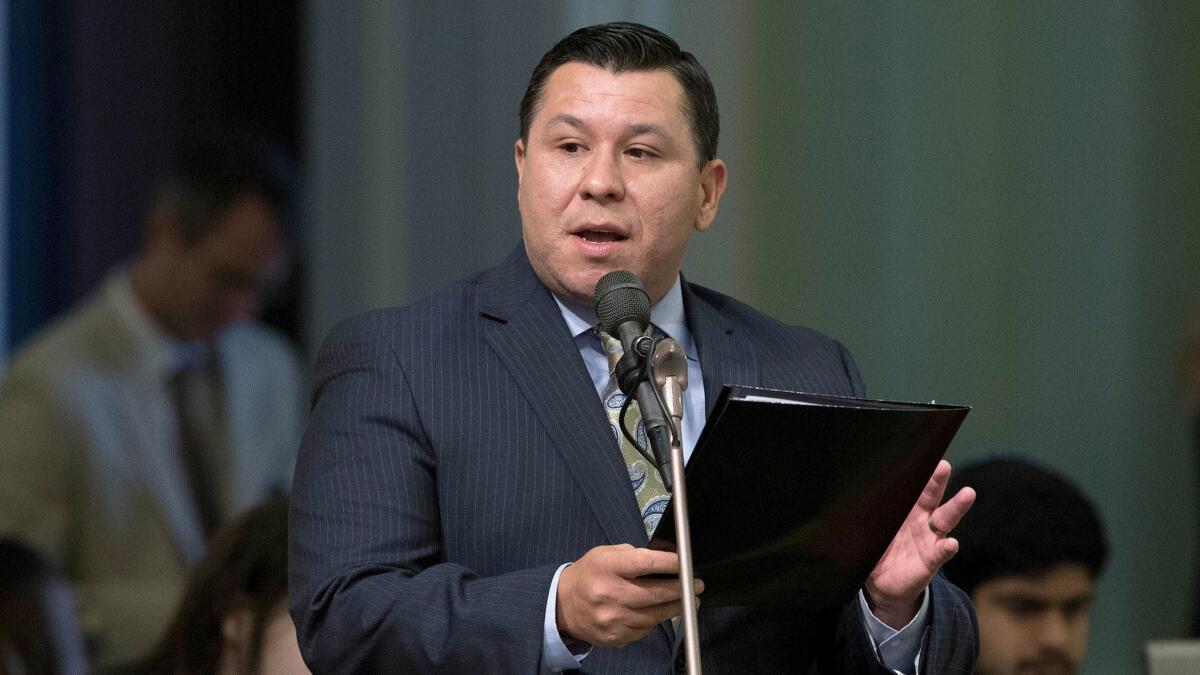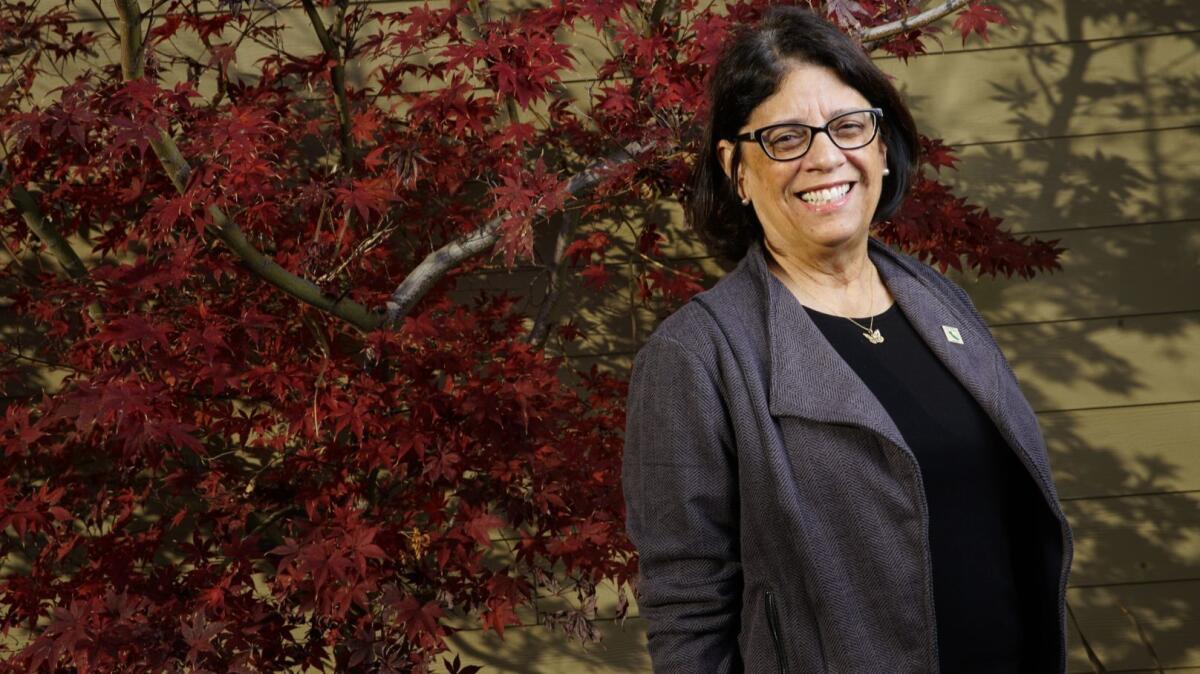California wanted to bridge the digital divide but left rural areas behind. Now that’s about to change

Until a few years ago, most students in Winters — a farming community of 7,000 west of Sacramento — did not have computers at home. So the city’s then-mayor, Cecilia Aguiar-Curry, pushed for a program that enabled the school district’s sixth-graders to check out laptops along with their textbooks.
Their parents were required to learn how to use the computers as well. For some, it was their first time surfing the web or sending an email.
“Now they could be a voice for their child,” said Aguiar-Curry, who grew up in Winters. She recalled that some parents were moved to tears. “Now they could work in the fields during the day, and at night they could come home and get on their child’s tablet and find out how they were doing in school.”
Over the last decade, California’s urban centers have become technology hubs, cities where free Wi-Fi and fiber optic lines are ubiquitous. But in low-income neighborhoods, across the state’s inland regions and in rural communities — often home to large migrant populations — families struggle to connect at all.
Some elected officials see that reality as proof that a digital divide is leaving many people behind. And they’ve set out to remedy it.
In 2007, the state established the California Advanced Services Fund to offer companies incentive to help bridge the gap. The program has allowed broadband providers to apply for nearly $300 million in grants to bring fiber optic, copper and other cable lines to some of the poorest and hardest-to-reach regions in the state.
The goal was to connect 98% of the 12.9 million homes across California, one that as of 2016 was within a few percentage points of being fulfilled. But while nearly 12.3 million homes in urban areas had some form of wireline broadband service by that year, less than half of roughly 680,900 households in rural areas had been connected.
Even as recently as October in the tiny town of Laytonville, north of San Francisco, connectivity was so sparse that residents such as Dorje Bond struggled to know when and where to evacuate during the wildfires.
Trish Steel, executive committee chair of the Broadband Alliance of Mendocino County, only recently was able to sign up for broadband service. Before heading off to college four years ago, her son would often do his homework between midnight and 5 a.m., when their satellite data plan was unlimited.
In Winters, Aguiar-Curry said she persuaded an independent provider in 2014 to extend free Wi-Fi to a nearby public housing complex for a few hours each night so that dozens of students could do their homework. Later, she looked into applying for federal public safety grants to run fiber optic lines through a nearby dam, connecting fire departments and police stations that had poor or no internet access.
After her election to the state Assembly in 2016, Aguiar-Curry decided to help revive the California Internet for All Now Act. The plan, long stymied by opponents in the Legislature, proposed pumping more money into the California Advanced Services Fund and reshaping its mission so that communities like hers would benefit.
It turned out to be one of the toughest state political battles of 2017.

The fund initially had focused on extending broadband service. Paid for over five years with a small surcharge on the phone bills of residents, the $325-million program was reauthorized in 2010 and helped cover up to 70% of the capital costs if providers such as AT&T and Verizon expanded their services to areas with slow internet speeds or no option other than dial-up modems.
But over the years, it was expanded to include funding to connect public housing and target other aspects of the digital divide, such as projects to teach residents web skills and increase their access to computers, laptops and other electronic devices.
As the program’s 2015 end date approached, however, thousands of families remained unconnected in small towns and rural areas where — with few customers — companies had less incentive to build. Bitter disagreements arose between community advocates and major telecoms over how any further increases in money for the program should be spent.
Legislative efforts to extend the phone surcharge failed twice. Critics said the state fund was a burden on consumers and poorly managed by the Public Utilities Commission, with some money being used to build connections in remote — but not necessarily needy — areas.
Aguiar-Curry said she took up the cause in the Assembly out of frustration that telecommunications companies were reporting that rural areas including Winters were already covered, even though residents complained of low speeds and dropped calls. A study by Yolo County confirmed that residents and businesses grappled with poor connectivity and often paid more for services.
She also had seen what access to the internet did for children in her city.
“Students who had never been outside of Winters, never even been an hour away to San Francisco, suddenly had their world open up,” she said.

In the Coachella Valley, more than 500 miles south of Winters, Democratic Assemblyman Eduardo Garcia also had been considering reviving the Internet for All Now Act. School officials there purchased 18,000 iPads in 2015 only to discover use of the tablets overloaded their network.
Garcia and Aguiar-Curry decided to work together on the legislation to reauthorize the California Advanced Services Fund; another Democrat, Assemblyman Miguel Santiago of Los Angeles, helped them build a bipartisan coalition of lawmakers from rural and urban areas to support it.
Their first discussions centered on calculating numbers under dispute: How do you measure what percentage of households in the state still need internet? What should the required internet speeds be?
In rural communities, residents wanted the state to help them go from “nothing to something,” but the rallying cry was “faster is better” in urban areas like Los Angeles and San Francisco, where pockets of disadvantaged residents still struggle with slow internet speeds or have no connectivity.
The Assembly members decided to focus first on rural districts, agreeing to authorize $330 million for the fund to connect 300,000 more households by 2023. This time, the state’s goal would be to connect 98% of households in each of 17 consortia, geographical regions formed by groups of tech advocates and local officials that span the state.
The plan overwhelmingly passed in the Assembly, with Republicans and Democrats alike denouncing connectivity problems across the state.
Assemblyman Jim Wood (D-Healdsburg) said some hospitals, schools and businesses in his district still struggle with a lack of internet access. Assemblyman James Gallagher (R-Yuba City) described homes in Oroville where one side of the street has high-speed internet service and the other can only connect with sluggish dial-up.
But the bill’s strong support didn’t last in the state Senate.
The North Bay region, represented by Democrats Wood and Sen. Mike McGuire of Healdsburg, became ground zero for opposition to the Internet for All Now Act once industry lobbyists and tech advocates ramped up efforts to influence the final details of the bill. Old fights over where and how to spend the money resurfaced.
There, community advocates believe, only a single fiber optic line runs through Sonoma, Mendocino and Humboldt counties. When that line goes dark, as it did when vandals attempted to cut it in 2015, there is no 911, no access to ATMs and no way to report an outage for thousands of residents.
“We all agree that the Golden State is the land of innovation, home of Silicon Valley. But four hours up 101, you step back in time,” McGuire said.
Still, as Wood joined Garcia, Aguiar-Curry and Santiago in crafting the details of the bill in Sacramento, regional community groups and Mendocino residents worried too many concessions were being made to the tech industry. They demanded higher internet speed standards. And they raised alarm over giving major telecoms, such as AT&T, Frontier and Comcast, too much leverage over smaller providers.
One Senate amendment to the bill prevented companies from applying for state broadband assistance in areas where federal broadband projects remain pending. Another provided companies with a right of first refusal, giving those already in an area the opportunity to stake their claim to build before newcomers, though residents said many of these larger providers had long offered only limited coverage.
Steel, of Mendocino’s broadband alliance, said companies could spend their federal dollars anywhere in the state, leaving no guarantee their projects would be completed in the area while smaller companies were shut out.
“They took a good bill and made it so bad that in our opinion [having] no bill would have been better,” she said.

The final version of the California Internet for All bill passed last year with overwhelming support in both chambers — but not without some rifts between lawmakers: Wood voted for it, McGuire against, citing concerns from residents like Steel.
It took effect Jan. 1 and will provide $300 million for infrastructure and $30 million for other efforts, such as helping families sign up for services.
In Winters, where all high school students now use Chromebooks and children are learning to code as early as second grade, school district officials applaud Aguiar-Curry’s efforts despite the legislative bargaining.
Aguiar-Curry said she knows the bill isn’t perfect; the state could only do so much, she said. But by providing communities with some infrastructure to start, it could help them improve their chances of winning federal and private dollars for more in the future.
In other words, she said, it would take a lot of places from nothing to something.
ALSO
Closely watched California Internet privacy bill dies in final minutes of legislative session
Why Silicon Valley is pouring money into efforts to repeal California's death penalty
Get the L.A. Times Politics newsletter
Deeply reported insights into legislation, politics and policy from Sacramento, Washington and beyond. In your inbox three times per week.
You may occasionally receive promotional content from the Los Angeles Times.








